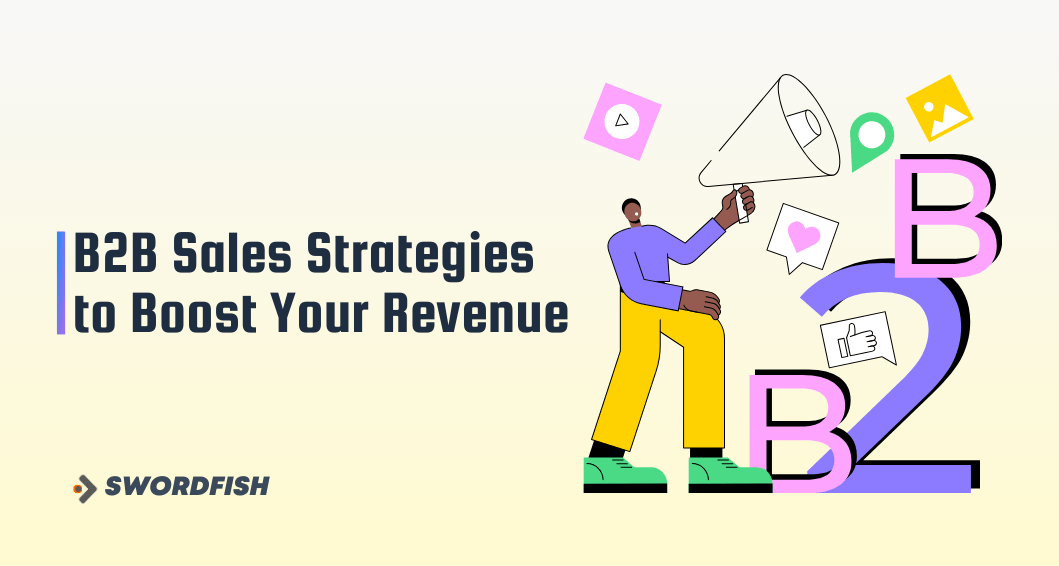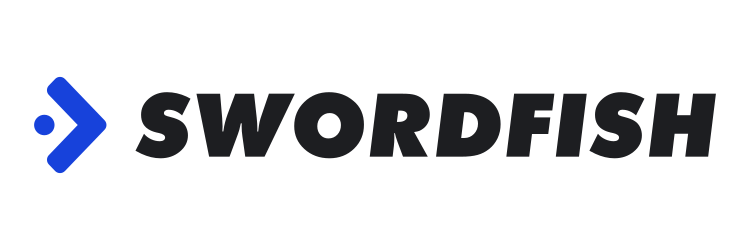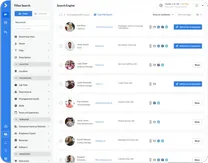
Successful B2B sales teams use specific, proven strategies to consistently outperform their competition. This guide covers 10 data-backed B2B sales strategies that can boost your revenue: from leveraging accurate contact data and personalizing outreach to implementing social selling and account-based marketing. The key is combining multiple approaches—prospect research, multi-channel engagement, value-driven conversations, and strategic follow-up, while using the right tools to scale your efforts. Teams implementing these strategies typically see 20-30% increases in conversion rates and 15-25% growth in revenue within 6-12 months.
The B2B sales landscape has evolved dramatically. What worked five years ago – cold calling random prospects or sending generic email blasts – simply doesn’t cut it anymore. Today’s B2B buyers are more informed, more selective, and expect personalized, value-driven interactions from the very first touchpoint.
If you’re looking to boost your revenue and close more deals, you need a strategic approach backed by data and proven methodologies. This comprehensive guide outlines 10 B2B sales strategies that top-performing teams use to consistently exceed their targets and drive sustainable growth.
10 B2B Sales Strategies to win more clients in 2025
You don’t need complex strategies or costly tools to boost your sales. Success comes from mastering the basics.
1. Leverage Accurate Contact Data for Precision Prospecting
The foundation of any successful B2B sales strategy starts with finding and connecting with the right prospects. According to Salesforce, 79% of marketing leads never convert to sales, often because teams are targeting the wrong contacts or using outdated information.
Why This Matters:
- Bad data costs businesses an average of $15 million annually
- 22% of sales time is wasted on prospecting with inaccurate contact information
- Teams with accurate data see 25% higher conversion rates
Implementation Strategy: Start by investing in reliable contact-finding tools that provide verified email addresses, direct dial numbers, and cell phones. Look for platforms offering real-time validation to ensure you’re reaching active contacts.
Focus on identifying decision-makers and influencers within your target accounts. Research shows that B2B purchases involve 6-10 decision-makers on average, so map out the complete buying committee rather than focusing solely on one contact.
Pro Tip: Use reverse lookup features to find contact information for specific companies or individuals you’ve identified through other research channels.
Try Swordfish free to access verified contact data for over 200 million professionals.
2. Implement Account-Based Marketing (ABM) for High-Value Prospects
Account-based marketing treats individual accounts as markets of one, delivering highly personalized campaigns to specific target companies. Companies using ABM see 208% higher revenue growth compared to those using traditional marketing approaches.
Key ABM Components:
- Identify high-value target accounts based on ideal customer profile
- Research account-specific challenges and business priorities
- Create customized content and messaging for each account
- Coordinate sales and marketing efforts around target accounts
Getting Started: Begin with 10-20 high-priority accounts. Research each company’s recent news, leadership changes, financial performance, and industry challenges. Develop account-specific value propositions that directly address their unique situations.
Use tools like LinkedIn Sales Navigator to track account activity and identify the right timing for outreach. When contacts from target accounts engage with your content or visit your website, prioritize immediate follow-up.
3. Perfect Your Multi-Channel Outreach Sequence
Single-channel outreach is dead. One research shows that prospects need 7-13 touchpoints before converting, and successful teams use 3-4 different channels in their outreach sequences.
Effective Multi-Channel Approach:
- Email: Personalized, value-driven messages
- LinkedIn: Connection requests with personalized notes
- Phone calls: Direct dials and cell phone outreach
- Social media: Engaging with prospects’ content before pitching
Sample 7-Touch Sequence:
- Day 1: LinkedIn connection request with personalized note
- Day 3: Email with relevant industry insight
- Day 7: Phone call (leave voicemail if no answer)
- Day 10: LinkedIn message sharing valuable resource
- Day 14: Email with case study relevant to their industry
- Day 21: Phone call attempt #2
- Day 30: Final email with different angle/offer
Track response rates across channels and adjust your approach based on what resonates with your specific audience.
4. Master the Art of Social Selling
Social selling involves using social media platforms to find, connect with, and nurture prospects. LinkedIn reports that social selling leaders create 45% more opportunities than peers with low social selling index scores.
Social Selling Best Practices:
- Optimize your LinkedIn profile with a professional headshot, compelling headline, and detailed experience section
- Share industry insights and valuable content regularly (aim for 3-5 posts per week)
- Engage authentically with prospects’ posts before reaching out
- Use LinkedIn Sales Navigator to track prospect activity and identify warm introduction opportunities
Building Your Social Selling Strategy: Start by following and engaging with key prospects’ content. Comment thoughtfully on their posts, share relevant articles, and participate in industry conversations. This positions you as a helpful resource rather than just another salesperson.
When you do reach out directly, reference specific content they’ve shared or accomplishments you’ve seen, making your message feel personal rather than templated.
5. Develop Compelling Value Propositions for Different Buyer Personas
Generic value propositions fall flat in today’s competitive landscape. Top-performing sales teams create specific value propositions for different buyer personas, addressing their unique challenges and priorities.
Creating Persona-Specific Value Props:
For C-Level Executives:
- Focus on ROI, competitive advantage, and strategic impact
- Use metrics and bottom-line impact
- Keep messaging concise and results-focused
IT Professionals:
- Emphasize technical capabilities, integration ease, and security
- Provide detailed specifications and implementation timelines
- Address potential technical challenges upfront
For End Users:
- Highlight ease of use, time savings, and day-to-day benefits
- Use relatable scenarios and peer testimonials
- Focus on solving immediate pain points
Research each prospect’s role, responsibilities, and likely priorities before crafting your initial outreach message.
6. Use Data-Driven Lead Scoring and Prioritization
Not all prospects are created equal. Implementing a data-driven lead scoring system helps you focus your time on the most promising opportunities, improving conversion rates and reducing sales cycle length.
Lead Scoring Factors:
- Demographic fit: Company size, industry, location
- Behavioral signals: Website visits, content downloads, email engagement
- Firmographic data: Company growth, recent funding, technology stack
- Intent data: Research activity around relevant keywords
Implementation Strategy: Start simple with a 100-point scoring system. Assign points based on factors most predictive of success in your business. For example:
- C-level title: 25 points
- Company size 100-500 employees: 20 points
- Downloaded key resource: 15 points
- Visited pricing page: 30 points
Focus your immediate attention on prospects scoring 70+ points, while nurturing lower-scoring leads with automated sequences.
7. Implement Consultative Selling Methodologies
The best B2B sales people position themselves as trusted advisors rather than product pushers. Consultative selling involves understanding prospects’ business challenges deeply and positioning your solution as the optimal path forward.
Consultative Selling Framework:
Discovery Phase:
- Ask open-ended questions about current processes
- Understand business goals and success metrics
- Identify gaps between current state and desired outcomes
- Map out decision-making process and key stakeholders
Analysis Phase:
- Synthesize discovery findings
- Identify specific areas where your solution adds value
- Quantify potential impact in terms they care about
- Prepare customized presentation addressing their specific needs
Recommendation Phase:
- Present tailored solution recommendation
- Connect features directly to their stated challenges
- Provide ROI calculations and success metrics
- Address potential concerns proactively
This approach typically results in higher conversion rates and larger deal sizes compared to traditional product-focused selling.
8. Leverage Customer Success Stories and Social Proof
B2B buyers want proof that your solution works for companies like theirs. Strategic use of case studies, testimonials, and success stories can significantly impact deal velocity and close rates.
Types of Social Proof:
- Customer case studies: Detailed stories showing measurable results
- Video testimonials: Authentic endorsements from satisfied customers
- Industry awards: Third-party validation of your solution
- Usage statistics: Number of customers, data processed, etc.
- Expert endorsements: Industry analyst recognition
Strategic Implementation: Develop case studies for different buyer personas and use cases. When engaging with prospects, share stories from similar companies facing comparable challenges.
For example, when speaking with a recruitment agency, share how Motion Recruitment improved productivity with accurate contact data. When talking to government contractors, highlight how Lockheed Martin achieved 400% more cleared candidates.
Create a library of 5-10 compelling success stories that address different objections and use cases you encounter regularly.
9. Optimize Your Sales Technology Stack
The right technology can dramatically improve your team’s efficiency and effectiveness. According to HubSpot, companies using sales automation see 14.5% increase in sales productivity and 12.2% reduction in marketing overhead.
Essential Sales Tools:
- CRM System: Centralized prospect and customer data management
- Contact Intelligence: Tools for finding and verifying prospect information
- Email Automation: Sequences and templates for consistent outreach
- Social Selling Platform: LinkedIn Sales Navigator for prospect research
- Analytics Tools: Performance tracking and optimization insights
Integration Strategy: Choose tools that integrate seamlessly with each other. Your contact-finding platform should sync with your CRM software which should connect to your email automation system. This eliminates manual data entry and ensures consistent information across platforms.
Focus on tools that provide real-time data validation. According to recent studies, 30% of contact data becomes obsolete annually, so real-time verification is crucial for maintaining outreach effectiveness.
10. Create a Systematic Follow-Up Process
Most deals are lost not because of poor initial outreach, but due to inadequate follow-up. Research shows that 80% of sales require five follow-up calls after the initial contact, yet 44% of salespeople give up after just one follow-up.
Systematic Follow-Up Framework:
Immediate Follow-Up (Within 24 hours):
- Send meeting recap with key discussion points
- Provide promised resources or information
- Set clear next steps and timeline
Ongoing Nurturing (7-30 days):
- Share relevant industry insights
- Introduce them to other team members when appropriate
- Send case studies addressing concerns they mentioned
Long-Term Relationship Building (30+ days):
- Quarterly check-ins with valuable content
- Invitations to industry events or webinars
- Updates on product developments relevant to their use case
Tools for Follow-Up Success: Use CRM task reminders and email automation to ensure no prospect falls through the cracks. Set up trigger-based follow-ups based on prospect behavior, such as email opens, link clicks, or website visits.
Consider implementing a lead nurturing system that automatically delivers valuable content to prospects who aren’t ready to buy immediately, keeping you top-of-mind for when their situation changes.
Measuring Success: Key Metrics to Track
Implementing these B2B sales strategies is only effective if you’re measuring the right metrics and continuously optimizing your approach.
Core Performance Indicators:
- Conversion rates: From prospect to qualified lead to closed deal
- Sales cycle length: Time from first contact to closed deal
- Deal size: Average contract value and revenue per customer
- Activity metrics: Calls made, emails sent, meetings booked
- Pipeline health: Quality of opportunities at each stage
Track these metrics monthly and identify trends. If conversion rates are dropping, examine your lead generation process. If sales cycles are lengthening, look at your follow-up sequences and value proposition clarity.
Putting It All Together: Your Implementation Roadmap
Don’t try to implement all 10 strategies simultaneously. Instead, follow this phased approach:
First Phase (Months 1-2): Foundation
- Implement accurate contact data platform
- Develop buyer personas and value propositions
- Set up basic CRM and tracking systems
Second Phase (Months 3-4): Outreach Optimization
- Create multi-channel outreach sequences
- Develop social selling presence
- Implement lead scoring system
Third Phase (Months 5-6): Advanced Strategies
- Launch account-based marketing campaigns
- Implement consultative selling training
- Optimize technology stack integrations
Regular review and optimization are crucial. Schedule monthly strategy sessions to analyze what’s working, what isn’t, and where you need to adjust your approach.
Conclusion
Successful B2B sales strategies combine the right mix of data-driven prospecting, personalized outreach, consultative selling, and systematic follow-up. The key is implementing these strategies systematically while continuously measuring and optimizing your approach.
Start with building a strong foundation of accurate prospect b2b data and clear value propositions. From there, layer on multi-channel outreach, social selling, and consultative methodologies. Remember that B2B sales is ultimately about building relationships and solving real business problems for your prospects.
The teams that consistently exceed their targets aren’t just working harder—they’re working smarter with proven B2B sales strategies that prioritize quality over quantity and value over volume.
Ready to boost your B2B sales performance? Start your free trial with Swordfish and access the accurate contact data you need to implement these proven strategies effectively.
Frequently Asked Questions: B2B Sales Strategies
What are B2B sales strategies?
B2B sales strategies are systematic approaches businesses use to sell products or services to other businesses. These strategies focus on building relationships, solving business problems, and driving revenue growth.
Key components include:
- Targeted prospecting – Finding and reaching the right decision-makers
- Multi-channel outreach – Using email, phone, LinkedIn, and social media
- Value-driven messaging – Focusing on ROI and business outcomes
- Relationship building – Positioning yourself as a trusted advisor
- Data-driven approach – Using analytics to optimize performance
- Account-based marketing – Treating high-value accounts as individual markets
What is the B2B sales funnel?
The B2B sales funnel is a visual representation of the customer journey from initial awareness to final purchase. It helps sales teams track prospects and optimize conversion at each stage.
The funnel stages include:
- Awareness – Prospects recognize they have a problem
- Interest – They research potential solutions
- Consideration – They evaluate specific vendors and options
- Intent – They show buying signals and request demos
- Evaluation – They compare final options and negotiate terms
- Purchase – They make the buying decision and sign contracts
- Retention – Post-sale relationship management and upselling
What are the 7 steps of the B2B selling process?
The B2B selling process is a systematic approach to converting prospects into customers through structured stages.
The 7 key steps are:
- Prospecting – Identify and research potential customers
- Initial contact – Make first outreach via email, phone, or social media
- Qualification – Determine if prospect fits your ideal customer profile
- Needs assessment – Discover specific challenges and requirements
- Presentation – Demonstrate how your solution solves their problems
- Handling objections – Address concerns and overcome resistance
- Closing – Secure commitment and finalize the deal
What is CRM in B2B sales?
CRM (Customer Relationship Management) is software that centralizes all prospect and customer interactions, helping sales teams manage relationships and track deals efficiently.
CRM benefits include:
- Centralized data – All contact information and interaction history in one place
- Pipeline management – Track deals through each sales stage
- Automation – Streamline follow-ups and routine tasks
- Analytics – Measure performance and identify trends
- Collaboration – Share information across sales and marketing teams
- Forecasting – Predict revenue and plan resources accordingly
Popular B2B CRM platforms: Salesforce, HubSpot, Pipedrive, and Zoho.
How to succeed in B2B sales?
Success in B2B sales requires combining the right strategies, tools, and mindset to consistently hit targets and build lasting customer relationships.
Essential success factors:
- Master consultative selling – Focus on solving problems, not pushing products
- Use accurate contact data – Invest in verified email and phone information
- Develop industry expertise – Understand your prospects’ business challenges
- Build systematic processes – Create repeatable workflows for consistency
- Leverage technology – Use CRM, automation, and analytics tools
- Practice persistent follow-up – Most deals require 5+ touchpoints
- Focus on value creation – Always lead with how you can help their business
Teams implementing these approaches typically see 20-30% increases in conversion rates within 6-12 months.


 View Products
View Products



